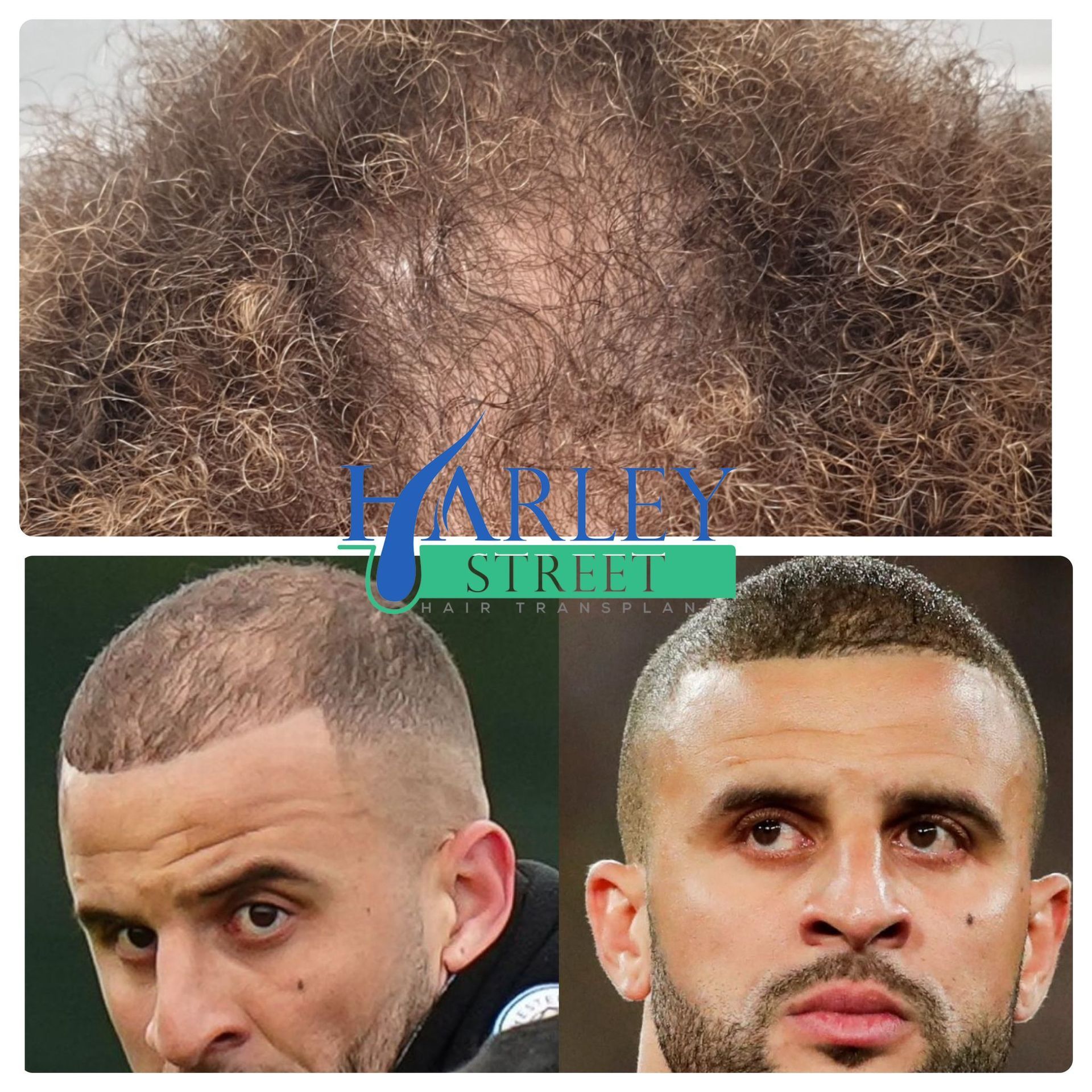FUE Hair Transplant
HOME > FUE HAIR TRANSPLANT
Check our results in action
ALL ABOUT FUE HAIR TRANSPLANT
A hair transplant technique called Follicular Unit Extraction (FUE) harvests individual hair grafts from the donor area of the scalp or body. By using this technique, it is possible to remove the grafts without leaving a linear scalp scar. Anyone facing excessive hair loss or hair thinning can get this transplant.
During an FUE hair transplant, around one to six thousand hair follicles from the donor area are implanted on the balding or thinning area of the patient’s scalp. Our professional team of doctors performs the finest FUE hair transplant in the UK at Harley Street Hair Transplants.
Men and women who suffer from male and female pattern baldness are eligible for this transplant. Our best FUE hair transplant UK and hair loss treatment for men guarantees to bring about the desired results and revive patients’ confidence.
FUE transplants do not hurt generally and provide excellent results over time. After the procedure, one of our hair transplant surgeons will always be available to guide you through the aftercare process. Harley Street also offers FUE hair transplant in Liverpool and FUE hair transplant in London. We ensure that our procedures are done with utmost care and precision.
FUE HAIR TRANSPLANT - ALL YOU NEED TO KNOW
A Follicular Unit Extraction (FUE) hair transplant is a minimally invasive surgical procedure that promotes new hair growth on your scalp and/or faces. Whether you are concerned about your receding hairline, eyebrows, or beard, an FUE treatment is often the perfect solution for many causes of thinning hair.
All of our hair transplant procedures, including FUE surgery, crown hair transplant, etc., are conducted by certified medical professionals with years of experience in hair restoration. Book your free consultation today and get rid of your hair loss concerns!
WHAT IS AN FUE TRANSPLANT?
The FUE transplant procedure looks to take anywhere between 1,000-6,000 individual hair follicles from the donor area and implant them onto the balding/thinning area of your scalp. This treatment, conducted by one of our hair restoration surgeons, in essence, “transports” hair that doesn’t get affected by the hormone DHT (which is one of the main causes of hair loss) onto the area of your scalp that requires hair, thus leaving a natural result as it is your own hair that is used.
WHY SHOULD YOU GET FUE?
Hair loss is a problem that can affect anyone in the UK. A 1998 study conducted by Rhodes showed that 42% of men between the ages of 18 and 49 showed signs of extensive hair loss. With the general scientific consensus being the pattern of baldness (androgenetic alopecia) is a result of genetics, this is a problem that many men and women will experience over the course of their life even without external influences such as stress, weight loss, and side effects to medical treatments such as chemotherapy.
WHAT CAN AN FUE HAIR TRANSPLANT TREAT?
Like many medical conditions, there is no singular explanation for hair loss. However, FUE hair transplants can be used to treat a number of different causes of hair loss:
Male Pattern Baldness (MPB) – Male Pattern Baldness refers to hair loss on the scalp area. Often, MPB begins with frontal receding before the gradual reduction in hair leads to full baldness on the top of the head. As men begin to age, this condition can become more and more prominent. As such, an FUE hair transplant can be used to prevent your hairline from receding any further and promote new hair growth.
Female Pattern Baldness (FPB) – Women can also feel the effects of hair loss just as much as men! Whilst 40% of women have admitted to showing signs of hair loss by the age of 50, this number reaches a staggering 55% by the time they reach 80 (see Yip 2007 & Sinclair 2015). Unlike men, many women report experiencing hair loss in different places than men. Commonly, FPB is categorized by visible signs of thinning of hair on the top of the scalp. This is often a result of women who have experienced increased hair shedding or a visible reduction in hair volume.
Beards and Eyebrows – If you struggle to grow facial hair or have experienced a loss or thinning of your beard/eyebrow hair, then an FUE hair transplant may be for you. Given that healthy donor hairs are extracted individually (or in small numbers) with FUE, this hair transplant method produces minimal scarring. Where other treatments such as FUT (sometimes referred to as the ‘strip method’) would not be able to treat facial hair problems, FUE is perfect!
HAIR TRANSPLANT SURGERY VS ALTERNATIVES
Whilst there are a number of treatments on the market today, an FUE hair transplant offers a long-term and fuller result than its alternatives.
Medication – Many patients, before they have come to us, try medication before hair restoration surgery. However, these drugs are DHT blockers and thus are used to slow down/stop further hair loss. The downsides are that they can have side effects (such as a decrease in libido) and are a treatment, so ongoing use is required.
Tattoo Treatments – Whilst tattooing your hair may be a long-term solution for those suffering from hair loss, this, unlike a hair transplant, does not stimulate hair growth. Rather, tattoo treatments are designed simply to mask or hide the true extent of a patient’s balding. FUE looks to implant healthy hair follicles into your balding area and actually prevent you from losing hair.
Synthetic Hair Wigs – Like other treatments, many of our other patients suffering from more extreme hair loss have used wigs to mask their hair loss. However, many synthetic wigs are often a short-term solution (typically lasting between 6-9 months) and can be uncomfortable for those wearing them.
Real Hair Wigs – Whilst real hair wigs are a longer-term solution (lasting up to a couple of years) than their synthetic counterparts; they can often be more expensive and still do not actively counteract your hair loss problems. Choosing to opt for an FUE hair transplant gives you the opportunity to have and style your own hair. Not to mention, it’s cheaper in the long term.
HOW DOES THE PROCEDURE WORK?
After you have received your free consultation with one of our hair transplant surgeons, arrive at our clinic on Harley Street. All our patients receive local anesthetic during hair transplant surgery. During the surgery, you shouldn’t feel anything more than a little bit of pressure, almost like a head massage!
At the beginning of the procedure, the lead hair transplant surgeon will begin by extracting follicular units from the donor area in natural groups of 1-4 (this is called a hair graft). These grafts, or follicular units, are circled by a tiny 1mm punch enabling an accurate and precise incision to be made. The follicular unit is then grasped gently and pulled away from the loose connective tissue that surrounds the unit under the skin.
Once the hair grafts have been taken, no more preparation is required. These small donor hairs are then implanted into the bald area one by one. This process is then repeated over and over again as desired.
As patients are left with tiny 1mm scars from follicle extraction, as opposed to other hair surgery treatments, which make larger incisions, the FUE recovery time is usually between 6-7 days.
THE FOUR STAGES OF A FUE HAIR TRANSPLANT
Before an FUE hair transplantation, a local anesthetic is administered, so you won’t feel more than a slight pressure during the procedure
- A Micro Punch tool is used to cut a small circle of skin around the individual follicular unit.
- The follicular unit (or graft) is gently prised away from the surrounding loose connective tissue under the skin.
- The harvested grafts are sorted according to how many individual hairs in each follicle.
- The grafts are then implanted into the balding area of the scalp.
WHO WILL DO YOUR FUE TRANSPLANT?
After your free initial consultation, your FUE hair transplant will be performed by one of our certified hair transplant doctors. All of our procedures are performed by doctors with a little help from our specialist nurses, ensuring you receive quality care and treatment.
WHAT IS THE DIFFERENCE BETWEEN FUE AND FUT?
There are a number of key differences between the FUT and FUE hair transplant methods.
Often called the ‘strip method’ or ‘strip surgery,’ FUT hair transplants take large strips of donor hairs from the patient’s scalp. These strips of hair are then dissected under a microscope before being implanted into the balding area. In comparison, follicular unit excision (FUE) takes much smaller hair grafts from the donor area, not only making it quicker but leaving most patients with much less scarring than those who have undergone FUT.
WHY CHOOSE FUE OVER FUT?
- During the procedure, there is less pain involved in FUE than in FUT. This is because no major or large incisions are required.
- FUE is also quicker than FUT. This is because no separations need to be made under a microscope, as is needed with FUT. This means you can tailor your hair transplant around your busy schedule!
- After the procedure, FUE typically has a much quicker recovery time when compared to FUT. This is because of the reduced scarring made by the 1mm punches. Patients are left with tiny scabs that quickly heal as opposed to large incisions made in the scalp.
DO FUE HAIR TRANSPLANTS HURT?
Patient safety comes first and foremost at our clinic. Some great news is that during the procedure, you should not feel any pain at all. This is because the treatment is done under local anesthetic. You shouldn’t feel a thing!
After your FUE hair transplant surgery, there may be some slight feelings of discomfort. However, as almost microscopic incisions are made on the scalp, you should not expect to feel any tightness as you would with FUT treatments.
After your procedure, one of our hair transplant surgeons will remain in contact with you and discuss the aftercare process with you extensively. If you have any problems, just get in touch with us!
RESULTS AND AFTERCARE
Following your hair transplantation procedure, you will have access to our post-transplant aftercare program and expert guidance whenever you need it.
It is important to keep the scalp hydrated during the first few days following the procedure in order to protect against infection and minimize scabbing. We provide full instructions for aftercare and are on hand to answer any concerns following your procedure.
It can take 2 to 3 months for the new follicles to take and naturally grow new hair, so regrowth may be uneven at first, but rest assured, you will soon benefit from thicker-looking hair. Although every patient’s recovery time and results may differ, most patients see full natural hair growth around 10 months following their procedure.
FREQUENTLY ASKED QUESTIONS
Patient Testimonials
What They Are Saying
Aside from achieving fantastic results, we believe that keeping in touch with our patients before, during and after their hair transplantation procedure is paramount – it helps to keep our patients feeling calm and in control. We’re always on hand to provide guidance, support and aftercare advice. Time and again, our patients tell us that this is what sets us apart from other clinics.






